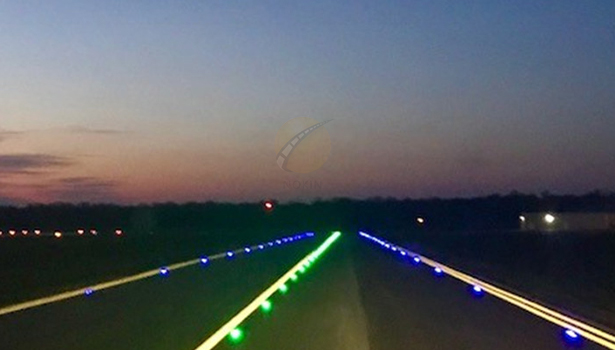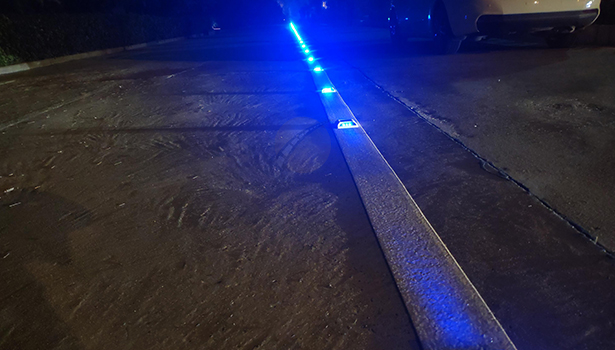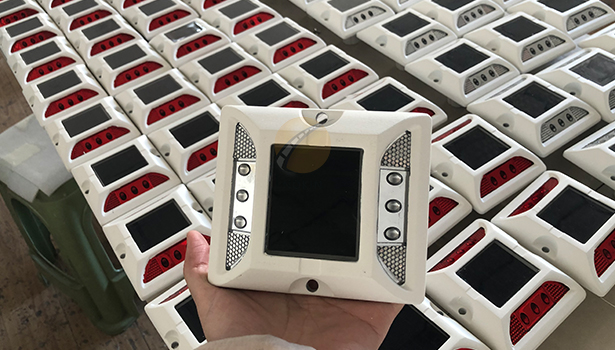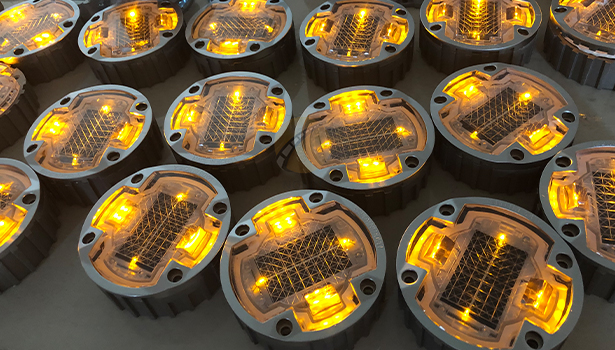Among the many elements of road safety, clear road markings are critical, especially in challenging environments such as nighttime and inclement weather. Cat’s eyes and Road studs, as important components of road infrastructure, each play a key role. In the next section, we will delve into the details of cat’s eyes and road studs, identifying their differences, functions, and application scenarios.

Cat’s Eye: The Classic Road Reflector
The cat’seye, also known asroad reflector, is a round, shiny device that we commonly see on roads and highways. Their simple yet efficient design has been a common feature on roads for decades. These devices are passive in nature and rely solely on the light from a vehicle's headlights to work. When light from the vehicle's headlights hits the cat’s eyes, the light is reflected back in the direction of the driver, enhancing the visibility of road markings and edges.
Origin and Invention
The story of the cat’s eyes began in 1934 when British inventor Percy Shaw was driving on a foggy night when the reflective eyes of a cat caught his attention. The cat eyes seemed to glow, guiding him to safety. This experience inspired Shaw to invent and patent a device that would do the same for drivers. The original cat eyes, consisting of a glass bead, rubber molding, and cast iron base, was not only bright enough to be seen from a distance but also durable enough to withstand inclement weather and vehicle impacts. Since then, cat eyeshave become an important part of road safety worldwide.
Construction and principle of cat’s eyes
At the heart of the cat’s eyes is a highly reflective lens that has been carefully designed to efficiently reflect the light from a vehicle's headlights, often using high-quality optical materials to ensure maximum reflection. One of the most innovative features of the cat eyes is its self-cleaning mechanism. When a vehicle drives over the cat eyes, the rubberized body compresses, causing the reflective lens to sink below the road surface. During the sinking process, any dirt or debris on the lens is wiped off, ensuring that the cat eyes is always clean and maintains its high reflective performance.
cat eyes have proven to be extremely effective in improving road safety. Studies have shown that cat eyescan reduce nighttime accidents by up to 47% and single-vehicle accidents by up to 60%. Cat's ability to provide clear visibility in adverse weather conditions such as fog, snow, and heavy rain makes it a trusted safety feature on roads worldwide.
Global application and adaptabilityof cat’s eyes
Although the cat eyes originated in the UK, it is now widely adopted around the world. Different regions have adapted it to suit their local climate and traffic conditions. In New Zealand, for example, white reflective cat eyes are placed on the centerline of the road at 10-meter intervals, while different colors such as red, yellow, and blue are used to indicate various road features. Red cat eyes mark the left edge of the road, yellow may be used to indicate no overtaking zones, and blue may be used to indicate special areas such as the location of fire hydrants.
In continental Europe, cat’s eyes are often used in combination with road markings coated with reflective paint, a combination that provides additional visibility for drivers. In some areas, cat eyes are not permanently installed but are deployed in specific locations where extra guidance is needed, such as sharp bends or complex road layouts. cat eyes are also an environmentally friendly option, with a low carbon footprint due to the lack of an external power source. Its durability and low maintenance requirements make it a cost-effective and sustainable road safety solution.
Color coding of cat’s eyes
The color coding of the cat eyes is a key aspect of its functionality. In the UK and many countries that follow similar standards:
- White cat eyes: used to separate lanes or mark the middle of the road, helping drivers to stay in their lane and avoid collisions with oncoming traffic.
- Red cat's-eye: Marks the left edge of a roadway or the hard shoulder of a highway as a clear indication for drivers to stay within a safe driving zone and avoid veering off the road.
- Amber cat eyes: Shows the center median of a two-lane road or freeway to help drivers distinguish between two opposing traffic streams.
- Green cat's-eye: Marks intersections, ramps, or feeder roads where they meet the main roadway, providing drivers with important guidance when turning or merging onto the main roadway.
- Green or Yellow cat eyes: Temporarily mark lane changes during road construction to ensure drivers are aware of changes in road layout and adjust their driving accordingly.
Road Studs: Modern Road Marking Solution
Road studs are traffic devices installed on the road surface with the primary purpose of marking the road and separating lanes to provide clear visual cues to drivers. They are usually made of hard, durable materials such as cast iron, plastic, or ceramic and covered with a reflective material that reflects the light from a vehicle's headlights, making them highly visible at night or in low visibility conditions.
Types of road studs based on material
Plastic road studs
Plastic road studs are the most common type and are made of a durable and impact-resistant plastic material that can withstand the weight of heavy vehicles. Their light weight and ease of installation make them particularly suitable for temporary road markings. For example, during short-term construction projects or the installation of temporary traffic management systems, plastic road studs can be quickly and easily placed on the road.
Ceramic road studs
Made of high-strength ceramic material, ceramic road studs are highly durable and long-lasting, able to withstand extreme weather conditions, heavy traffic, and other harsh environmental factors. Their high visibility and excellent guidance properties make them suitable for use in areas where long-term, reliable road markings are required, such as busy highways or areas with high traffic volumes.
Aluminum road studs
Made from high-quality aluminum, aluminum road studs are known for their durability and corrosion resistance, making them ideal for use in harsh outdoor environments. These road studs are commonly used on roads and highways that need to stand the test of time and various weather elements. Their raised design helps to improve visibility and provide clear guidance to drivers.
Glass road studs
Made of tempered glass material, glass road studs are highly durable and impact resistant. Their high visibility makes them an excellent choice for pedestrian safety areas such as crosswalks. The glass material effectively reflects light, ensuring that drivers can clearly see the markings and slow down or stop if necessary.
Solar road studs
Solar road studs are a more advanced type that utilizes solar panels to power their lights. This makes them particularly useful on remote rural roads or off-grid areas where there is no electricity supply. Solar road studs can be actively illuminated, providing enhanced visibility even in complete darkness, utilizing energy stored during the day.

Functions and applicationsof road studs
Lane separation
Road studs are widely used to mark lane lines. At night or in low visibility conditions such as rain, fog, or snow, they clearly reflect lane boundaries, helping to prevent vehicles from drifting out of their lanes, reduce the risk of scrapes and accidents, and maintain a smooth flow of traffic.
Speed reduction alert
Road studs can be used as a reminder for drivers to slow down on certain roadways where slowing down is required, such as near schools, at sharp turns, or before intersections. Their raised shape provides a tactile and visual cue for drivers to reduce speed and drive more cautiously.
Navigational guidance
Road studs mounted on the centerline or edge of a roadway help drivers stay on course, especially at night or in poor weather conditions. They act as continuous guide signs to ensure drivers stay on the right path and avoid getting lost or confused, especially when the road layout is complex.
Improved visibility
Road studs play a key role in improving road visibility. By reflecting light from the vehicle's headlights, it is easier for drivers to see the road ahead, even in low-light conditions. This enhanced visibility helps drivers anticipate potential hazards and react in a timely manner.
Hazard warning
Road studs can also be used to warn drivers of potential hazards on the road. For example, in areas such as sharp turns, railroad crossings, or pedestrian crossings, road studs can be placed to alert drivers to the presence of these hazards, allowing them to slow down and approach with caution.
Reducing speed
In areas where speeding is a serious problem, potholes can be used to reduce vehicle speeds. Vibrating strips, for example, act as a type of road stud, creating vibrations and noise as vehicles drive over them, causing discomfort to drivers and thus prompting them to slow down, especially when approaching a hazardous area.

Key Differences Between Cat Eyes And Road Studs
Reflective mechanism
Cat eyes
Cat eyes use a built-in reflective lens or optical glass with an internal reflective mechanism that has been optically designed to reflect light in a more focused and efficient manner. This design makes the cat eyes highly visible at night or in low visibility conditions, and its reflective effect is achieved by passive reflection from the vehicle's headlights, where the light is reflected back in the direction of the driver.
Road studs
Road studs usually use reflective coatings or sheets to achieve a reflective effect, the intensity of which depends on the angle of incidence of the light and the properties of the reflective material. Some advanced road studs, such as solar studs, can also be actively illuminated, which is very different from the passive reflection mechanism of cat eyes.
Structure and design
Cat eyes
Cat eyes designs are more complex and often contain multiple reflectors or lenses with a convex shape. The raised shape helps to direct the reflected light more efficiently in the direction of the driver's vision, and the overall design not only enhances its reflective properties but also increases its durability in harsh conditions. The self-cleaning feature that is part of its design further helps to maintain functionality over time.
Road studs
Road studs are generally simple in design and are usually flat or slightly raised structures that are easy to install and maintain. They come in a variety of shapes, including square, round, or rectangular, with the shape chosen primarily based on the type of roadway and specific application scenario. For example, square road studs may be used in urban areas where more defined lane markings are required, while round road studs may be better suited for curved sections of road.
Materials and durability
Cat eyes
Cat eyes are made of high-strength metal or glass, and the internal reflective mechanism is usually made of high-quality optical glass or special materials, a construction that gives them a long service life and high durability. Even after prolonged exposure to the elements, the cat eyes retains its reflective properties and is able to withstand vehicle impacts and weather conditions without significant deterioration.
Road studs
Road studs are mostly made of metal, plastic, or ceramic materials, which have high strength and abrasion resistance and can be adapted to different types of road conditions. However, the reflective material on common road studs can fail over time, especially under the constant pressure of frequent traffic. For example, reflective coatings on plastic road studs may fade or flake off after prolonged use, reducing their visibility.
Application scenarios
Cat eyes
Cat eyes are typically used in low visibility road environments and are especially important on suburban roads, mountain roads, tunnels, or temporary construction sections. At night, in foggy conditions or on unlit roads, their efficient reflective properties provide critical guidance to drivers. They are also widely used on highways and high-risk roads to improve driver concentration and safety.
Road studs
Road studs are widely used in a variety of scenarios, including city streets, highways, and parking lots. They are mainly used to mark and separate lanes under normal traffic conditions and are commonly used on flat roads and in high traffic areas, where their simple design and installation can effectively guide drivers and maintain traffic order.

To summarize, there are obvious differences between cat eyes and road studs in terms of reflective mechanism, structural design, material composition, and application scenarios. With its unique optical design and self-cleaning function, cat eyes performs well in low visibility environments, while road studs are widely used in various road scenarios with diverse materials and simple and practical designs.
Despite their differences, both cat eyes and road studs play an irreplaceable and important role in ensuring road safety, providing a strong guarantee for the safety of drivers, passengers, and pedestrians. In our daily driving, we should pay more attention to these road devices and fully recognize their significance in enhancing road safety.

 English
English  Arabic
Arabic  Bulgarian
Bulgarian  Chinese (Simplified)
Chinese (Simplified)  Chinese (Traditional)
Chinese (Traditional)  Croatian
Croatian  Czech
Czech  Danish
Danish  Dutch
Dutch  Finnish
Finnish  French
French  German
German  Greek
Greek  Hindi
Hindi  Italian
Italian  Japanese
Japanese  Korean
Korean  Norwegian
Norwegian  Polish
Polish  Portuguese
Portuguese  Romanian
Romanian  Russian
Russian  Spanish
Spanish  Swedish
Swedish  Catalan
Catalan  Filipino
Filipino  Hebrew
Hebrew  Indonesian
Indonesian  Latvian
Latvian  Lithuanian
Lithuanian  Serbian
Serbian  Slovak
Slovak  Slovenian
Slovenian  Ukrainian
Ukrainian  Vietnamese
Vietnamese  Albanian
Albanian  Estonian
Estonian  Galician
Galician  Hungarian
Hungarian  Maltese
Maltese  Thai
Thai  Turkish
Turkish  Persian
Persian  Afrikaans
Afrikaans  Malay
Malay  Swahili
Swahili  Irish
Irish  Welsh
Welsh  Belarusian
Belarusian  Icelandic
Icelandic  Macedonian
Macedonian  Yiddish
Yiddish  Armenian
Armenian  Azerbaijani
Azerbaijani  Basque
Basque  Georgian
Georgian  Haitian Creole
Haitian Creole  Urdu
Urdu  Bengali
Bengali  Bosnian
Bosnian  Cebuano
Cebuano  Esperanto
Esperanto  Gujarati
Gujarati  Hausa
Hausa  Hmong
Hmong  Igbo
Igbo  Javanese
Javanese  Kannada
Kannada  Khmer
Khmer  Lao
Lao  Latin
Latin  Maori
Maori  Marathi
Marathi  Mongolian
Mongolian  Nepali
Nepali  Punjabi
Punjabi  Somali
Somali  Tamil
Tamil  Telugu
Telugu  Yoruba
Yoruba  Zulu
Zulu  Myanmar (Burmese)
Myanmar (Burmese)  Chichewa
Chichewa  Kazakh
Kazakh  Malagasy
Malagasy  Malayalam
Malayalam  Sinhala
Sinhala  Sesotho
Sesotho  Sudanese
Sudanese  Tajik
Tajik  Uzbek
Uzbek  Amharic
Amharic  Corsican
Corsican  Hawaiian
Hawaiian  Kurdish (Kurmanji)
Kurdish (Kurmanji)  Kyrgyz
Kyrgyz  Luxembourgish
Luxembourgish  Pashto
Pashto  Samoan
Samoan  Scottish Gaelic
Scottish Gaelic  Shona
Shona  Sindhi
Sindhi  Frisian
Frisian  Xhosa
Xhosa 



